Spirited Away
9.3 /10 2 Votes
Featured song Always With Me | 8.6/10 IMDb Genre Animation, Adventure, Family Duration Country Japan | |||||||||||||||||||||||||||||||||
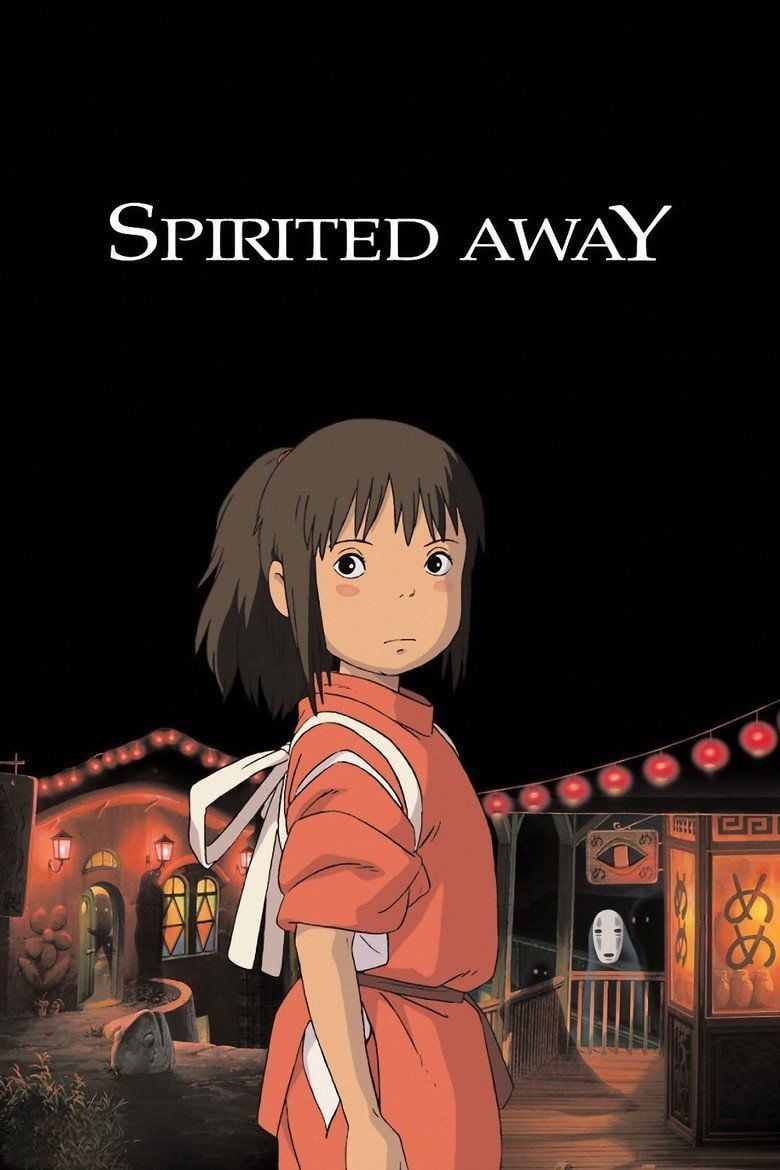 | ||||||||||||||||||||||||||||||||||
Release date July 20, 2001 (2001-07-20) Characters Haku (Miyu Irino), Yubaba (Mari Natsuki), Kamaji (Bunta Sugawara), Zeniba (Mari Natsuki), Chihiro Ogino (Rumi Hiiragi) Similar movies The Sorcerer's Apprentice , Oz: The Great and Powerful , Howl's Moving Castle , Kiki's Delivery Service , , Mary Poppins Tagline The tunnel led Chihiro to a mysterious town... | ||||||||||||||||||||||||||||||||||
Spirited away official trailer
Spirited Away (Japanese: 千と千尋の神隠し, Hepburn: Sen to Chihiro no Kamikakushi, "Sen and Chihiro's Spiriting Away") is a 2001 Japanese animated fantasy film written and directed by Hayao Miyazaki and produced by Studio Ghibli. The film stars Rumi Hiiragi, Miyu Irino, Mari Natsuki, Takeshi Naito, Yasuko Sawaguchi, Tsunehiko Kamijō, Takehiko Ono, and Bunta Sugawara, and tells the story of Chihiro Ogino (Hiiragi), a sullen ten-year-old girl who, while moving to a new neighborhood, enters the spirit world. After her parents are transformed into pigs by the witch Yubaba (Natsuki), Chihiro takes a job working in Yubaba's bathhouse to find a way to free herself and her parents and return to the human world.
Contents
- Spirited away official trailer
- Plot
- Development and inspiration
- Music and soundtrack
- English adaptation
- Themes
- Box office and theatrical release
- Home media
- Critical response
- Live action remake
- References
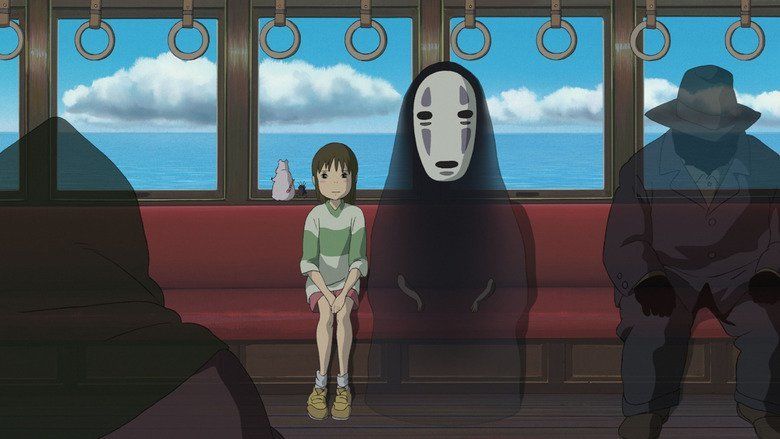
Miyazaki wrote the script after he decided the film would be based on the 10-year-old daughter of his friend, associate producer Seiji Okuda, who came to visit his house each summer. At the time, Miyazaki was developing two personal projects, but they were rejected. With a budget of US$19 million, production of Spirited Away began in 2000. During production, Miyazaki realized the film would be over three hours long and decided to cut out several parts of the story. Pixar director John Lasseter, a fan of Miyazaki, was approached by Walt Disney Pictures to supervise an English-language translation for the film's North American release. Lasseter hired Kirk Wise as director and Donald W. Ernst as producer of the adaptation. Screenwriters Cindy Davis Hewitt and Donald H. Hewitt wrote the English-language dialogue, which they wrote to match the characters' original Japanese-language lip movements.

The film was theatrically released in Japan on 20 July 2001 by distributor Toho, and became the most successful film in Japanese history, grossing over $289 million worldwide and receiving widespread critical acclaim. The film overtook Titanic (at the time the top-grossing film worldwide) in the Japanese box office to become the highest-grossing film in Japanese history with a ¥30.4 billion total. Spirited Away is frequently ranked among the greatest animated films. It won the Academy Award for Best Animated Feature at the 75th Academy Awards, making it the only hand drawn animated film and Japanese animated film to win best animated film; the Golden Bear at the 2002 Berlin International Film Festival, tied with Bloody Sunday; and is on the British Film Institute's list of "Top fifty films for children up to the age of 14".
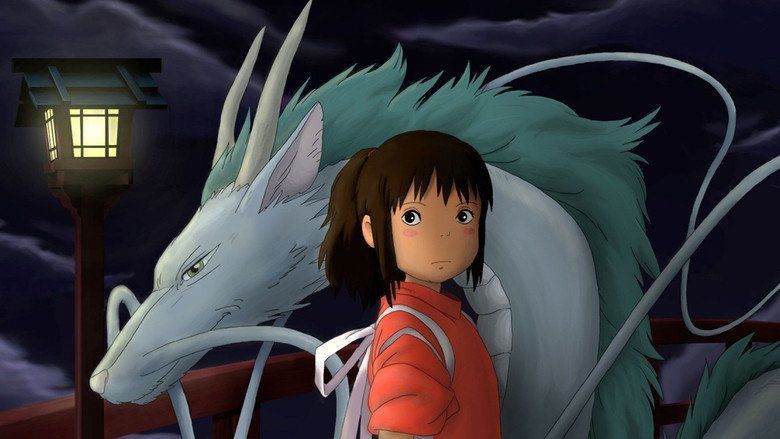
In 2016, it was voted the fourth best film of the 21st century as picked by 177 film critics from around the world, making it the highest ranking animated film on the list.
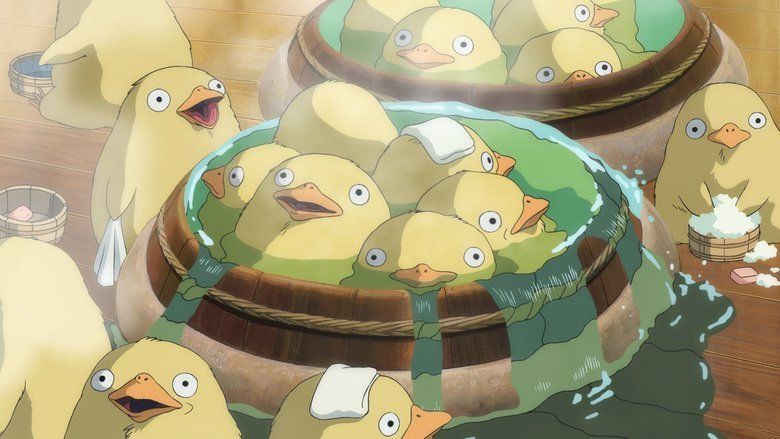
It was also named the second "Best Film of the 21st Century So Far" in 2017 by the New York Times.
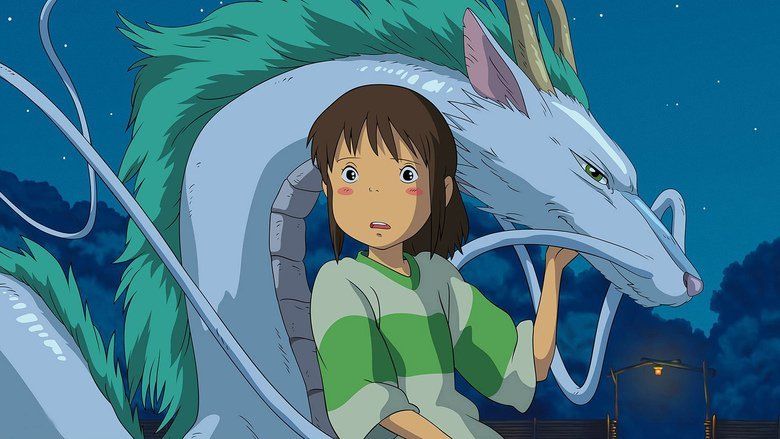
Plot

Ten-year-old Chihiro Ogino and her parents are traveling to their new home when her father takes a wrong turn. They unknowingly enter a magical world that Chihiro's father insists on exploring. While Chihiro's parents eat like pigs at an empty restaurant stall, Chihiro finds an exquisite bathhouse and meets a young boy named Haku who warns her to return across the river before sunset. However, Chihiro discovers too late that her parents have turned into pigs and she is unable to cross the flooded river, becoming trapped in the spirit world.
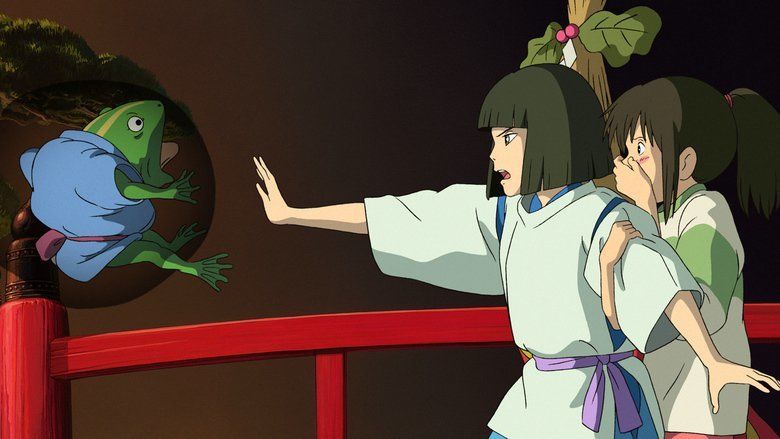
After finding Chihiro, Haku has her ask for a job from the bathhouse's boiler-man, Kamaji, a spider yōkai commanding the susuwatari. Kamaji already has soot spirits working for him, but he asks the worker Lin to send Chihiro to the witch, Yubaba, who runs the bathhouse; Yubaba tries to frighten Chihiro away, but she persists, so Yubaba gives Chihiro a contract to work for her which Yubaba takes her name and renames her Sen (千). While visiting her parents' pigpen, Sen finds a goodbye card addressed to Chihiro and realizes that she has already forgotten her name. Haku warns her that Yubaba controls people by taking their names and that if she forgets hers like he has forgotten his, she will not be able to leave the spirit world. While working, Sen invites a silent masked creature named No-Face inside, believing him to be a customer. A 'stink spirit' arrives as Sen's first customer. She discovers he is the spirit of a polluted river. In gratitude for cleaning him, he gives Sen a magic emetic dumpling. Meanwhile, No-Face tempts a worker with gold, then swallows him. He demands food and begins tipping extensively. As the workers swarm him hoping to be tipped, he swallows two other greedy workers.
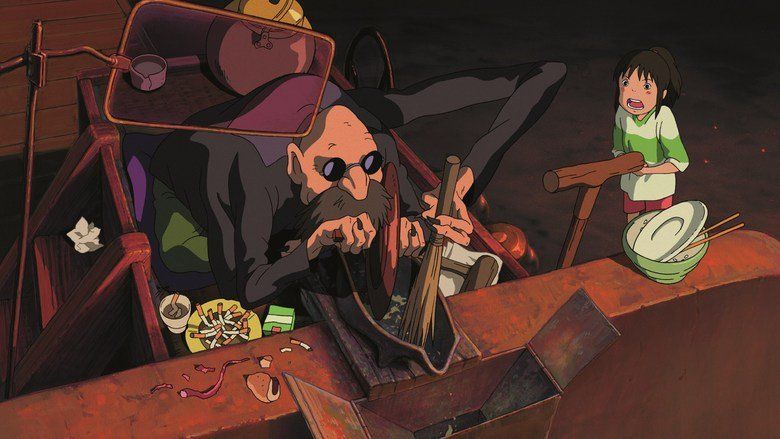
Sen discovers paper shikigami attacking a dragon and recognizes the dragon as Haku transformed. When a grievously-injured Haku crashes into Yubaba's penthouse, Sen follows him upstairs. When she reaches Haku, a shikigami that stowed away on her back transforms into Zeniba, Yubaba's twin sister. She transforms Yubaba's baby son Boh into a mouse, creates a decoy baby and turns Yubaba's bird creature into a tiny bird. Zeniba tells Sen that Haku has stolen a magic golden seal from her, and warns Sen that it carries a deadly curse. After Haku dives to the boiler room with Sen and Boh on his back, she feeds him part of the dumpling, causing him to vomit both the seal and a black slug, which Sen crushes with her foot.
With Haku unconscious, Sen resolves to return the seal and apologize for Haku. Before she leaves the bathhouse, Sen confronts No-Face, who is now massive, and feeds him the rest of the dumpling. No-Face chases Sen out of the bathhouse, steadily vomiting out those he has eaten. Sen, No-Face and Boh travel to see Zeniba. Yubaba orders that Sen's parents be slaughtered, but Haku negotiates freedom for Sen and her parents after revealing that Boh is missing and offering to retrieve him. But if Sen fails Yubaba's final test, the deal will be broken.
Sen, No-Face and Boh meet with the now benevolent Zeniba, who reveals that Sen's love for Haku broke her curse and that Yubaba used the black slug to control Haku. Haku appears in his dragon form and flies Sen and Boh to the bathhouse. No-Face becomes Zeniba's spinner. In midflight, Sen recalls falling in her youth into the Kohaku River and being washed safely ashore, thus revealing Haku's real identity as the Kohaku River. When they arrive at the bathhouse, Yubaba forces Sen to identify her parents from among a group of pigs in order to break their curse. After Sen answers that none of the pigs are her parents, her contract combusts and she is given back her real name. Haku takes her to the now dry riverbed and vows to meet her again. Chihiro crosses the riverbed to her restored parents, who do not remember anything. They quietly walk back to their car (which is now covered in dust) and drive away.
Development and inspiration
Every summer, Hayao Miyazaki spent his vacation at a mountain cabin with his family and five girls who were friends of the family. The idea for Spirited Away came about when he wanted to make a film for these friends. Miyazaki had previously directed films such as My Neighbor Totoro and Kiki's Delivery Service, which were for small children and teenagers, but he had not created a film for ten-year-old girls. For inspiration, he read shōjo manga magazines like Nakayoshi and Ribon the girls had left at the cabin, but felt they only offered subjects on "crushes" and romance. When looking at his young friends, Miyazaki felt this was not what they "held dear in their hearts" and decided to produce the film about a girl heroine whom they could look up to instead.
Miyazaki had wanted to produce a new film for years, but his two previous proposals (one based on the Japanese book Kirino Mukouno Fushigina Machi, and another about a teenage heroine) were rejected. Miyazaki's third proposal, which ended up becoming Sen and Chihiro Spirited Away, was more successful. The three stories revolved around a bathhouse that was inspired by one in Miyazaki's hometown. Miyazaki thought the bathhouse was a mysterious place, and there was a small door next to one of the bathtubs in the bathhouse. Miyazaki was always curious to what was behind it, and he made up several stories about it, one of which inspired the bathhouse setting of Spirited Away.
Production of Spirited Away commenced in 2000 on a budget of ¥1.9 billion ($15 million). Disney invested 10% of the cost for the right of first refusal for American distribution. As with Princess Mononoke, Miyazaki and the Studio Ghibli staff experimented with computer animation. With the use of more computers and programs such as Softimage, the staff learned the software, but used the technology carefully so that it enhanced the story, instead of 'stealing the show'. Each character was mostly hand-drawn, with Miyazaki working alongside his animators to see they were getting it just right. The biggest difficulty in making the film was to reduce its length. When production started, Miyazaki realized it would be more than three hours long if he made it according to his plot. He had to delete many scenes from the story, and tried to reduce the "eye-candy" in the film because he wanted it to be simple. Miyazaki did not want to make the hero a "pretty girl." At the beginning, he was frustrated at how she looked "dull" and thought, "She isn't cute. Isn't there something we can do?" As the film neared the end, however, he was relieved to feel "she will be a charming woman."
Miyazaki based some of the buildings in the spirit world on the buildings in the real-life Edo-Tokyo Open Air Architectural Museum in Koganei, Tokyo, Japan. He often visited the museum for inspiration while working on the film. Miyazaki had always been interested in the Pseudo-Western style buildings from the Meiji period that were available there. The museum made Miyazaki feel nostalgic, "especially when I stand here alone in the evening, near closing time, and the sun is setting – tears well up in my eyes." Another major inspiration was the Notoyaryokan, a traditional Japanese inn located in Yamagata Prefecture, famous for its exquisite architecture and ornamental features. While some guidebooks and articles claim that the old gold town of Jiufen in Taiwan served as an inspirational model for the film, Miyazaki has denied this. The Dōgo Onsen is also often said to be a key inspiration for the Spirited Away onsen/bathhouse.
Music and soundtrack
The film score of Spirited Away was composed and conducted by Miyazaki's regular collaborator Joe Hisaishi, and performed by the New Japan Philharmonic. The soundtrack received awards at the 56th Mainichi Film Competition Award for Best Music, the Tokyo International Anime Fair 2001 Best Music Award in the Theater Movie category, and the 17th Japan Gold Disk Award for Animation Album of the Year. Later, Hisaishi added lyrics to "One Summer's Day" and named the new version "The Name of Life" (いのちの名前, "Inochi no Namae") which was performed by Ayaka Hirahara.
The closing song, "Always With Me" (いつも何度でも, Itsumo Nandodemo, literally, "Always, No Matter How Many Times") was written and performed by Youmi Kimura, a composer and lyre-player from Osaka. The lyrics were written by Kimura's friend Wakako Kaku. The song was intended to be used for Rin the Chimney Painter (煙突描きのリン, Entotsu-kaki no Rin), a different Miyazaki film which was never released. In the special features of Japanese DVD, Hayao Miyazaki explains how the song in fact inspired him to create Spirited Away. The song itself would be recognized as Gold at the 43rd Japan Record Awards.
Besides the original soundtrack, there is also an image album, titled Spirited Away Image Album (千と千尋の神隠し イメージアルバム, Sen to Chihiro no Kamikakushi Imēji Arubamu), that contains 10 tracks.
English adaptation
Both Walt Disney Pictures and DreamWorks bid for the US distribution rights. Eventually, Disney won the rights to dub the English adaptation of Spirited Away, under the supervision of Pixar animator John Lasseter. A Miyazaki fan, Lasseter would sit with his staff and watch Miyazaki's work when encountering story problems, and at one point they did so with Spirited Away, which impressed Lasseter. Upon hearing his reaction to the film, people at Disney asked Lasseter if he would be interested in trying to bring Spirited Away to an American audience. Lasseter agreed to be executive producer for English adaptation. Soon, several others began to join the project: Beauty and the Beast co-director Kirk Wise and Aladdin co-producer Donald W. Ernst joined Lasseter as director and producer of Spirited Away respectively. Cindy Davis Hewitt and Donald H. Hewitt penned the English-language dialogue, which they wrote to match the characters' original Japanese-language lip movements.
The cast of the film consisted of Daveigh Chase, Jason Marsden, Susan Egan, David Ogden Stiers, and John Ratzenberger. Advertising was limited, and Spirited Away was only mentioned in a small scrolling section of their film page on Disney's official website. Disney had sidelined their official website for Spirited Away, and given the film a comparatively small promotional budget. Marc Hairston argues that this was a justified response to Ghibli's retention of the merchandising rights to the film and characters, which limited Disney's ability to properly market the film.
Themes
The film has been compared to Lewis Carroll's Alice's Adventures in Wonderland as the stories have some elements in common such being set in a fantasy world, the plots including a disturbance in logic and stability, and there being motifs such as food having transformational qualities; though developments and themes are not shared. Among other stories compared to Spirited Away, The Wonderful Wizard of Oz is seen to be more closely linked thematically.
The major themes of Spirited Away center on the protagonist Chihiro and her liminal journey through the realm of spirits. The archetypal entrance into another world demarcates Chihiro's status as one somewhere between child and adult. Chihiro also stands outside societal boundaries in the supernatural setting. The use of the word kamikakushi (literally "hidden by gods") within the Japanese title, and its associated folklore, reinforces this liminal passage: "Kamikakushi is a verdict of 'social death' in this world, and coming back to this world from Kamikakushi meant 'social resurrection.'"
Yubaba has many similarities to The Coachman from Pinocchio, in the sense that she transforms humans into pigs in a similar way that the boys of Pleasure Island were transformed into donkeys. Upon gaining employment at the bathhouse, Yubaba's seizure of Chihiro's true name symbolically kills the child, who must then assume adulthood. She then undergoes a rite of passage according to the monomyth format; to recover continuity with her past, Chihiro must create a new identity.
Along with its function within the ostensible coming of age theme, Yubaba's act of taking Chihiro's name and replacing it with Sen (an alternate reading of "chi", the first character in Chihiro's name - lit. "one thousand"), is symbolic of capitalism's single-minded concern with value, reflecting the film's exploration of capitalism and its effect on traditional Japanese culture.
Yubaba is stylistically unique within the bathhouse, wearing Western dress and living among European décor and furnishings, in contrast with the minimalist Japanese style of her employee's quarters, representing the Western capitalist influence over Japan in its Meiji period and beyond. The meiji design of the abandoned theme park is the setting for Chihiro's parents' transformation - the family arrives in an imported Audi car and the father wears a European style polo shirt, reassuring Chihiro that he has "credit cards and cash", before their morphing into literal consumerist pigs.
Spirited Away contains critical commentary on modern Japanese society concerning generational conflicts and environmental issues. Chihiro has been seen as a representation of the shōjo, whose roles and ideology had changed dramatically since post-war Japan.
Just as Chihiro seeks her past identity, Japan, in its anxiety over the economic downturn occurring during the release of the film in 2001, sought to reconnect to past values. In an interview, Miyazaki has commented on this nostalgic element for an old Japan.
However, the bathhouse of the spirits cannot be seen as a place free of ambiguity and darkness. Many of the employees are rude to Chihiro because she is human, and corruption is ever-present; it is a place of excess and greed, as depicted in the initial appearance of the No-Face. In stark contrast to the simplicity of Chihiro's journey and transformation is the constant chaotic carnival in the background.
There are two major instances of allusions to environmental issues within the movie. The first is seen when Chihiro is dealing with the "stink spirit." The stink spirit was actually a river spirit, but it was so corrupted with filth that one couldn't tell what it was at first glance. It only became clean again when Chihiro pulled out a huge amount of trash, including car tires, garbage, and a bicycle. This alludes to human pollution of the environment, and how people can carelessly toss away things without thinking of the consequences and of where the trash will go. The second allusion is seen in Haku himself. Haku does not remember his name and lost his past, which is why he is stuck at the bathhouse. Eventually, Chihiro remembers that he used to be the spirit of the Kohaku River, which was destroyed and replaced with apartments. Because of human's need for development, they destroyed a part of nature, causing Haku to lose his home and identity. This can be compared to deforestation and desertification; humans tear down nature, cause imbalance in the ecosystem, and demolish animals' homes to satisfy their want for more space (housing, malls, stores, etc.) but don't think about how it can affect other living things.
Additional themes are expressed through the No-Face, who reflects the characters which surround him, learning by example and taking the traits of whomever he consumes. This nature results in No-Face's monstrous rampage through the bath house. After Chihiro saves No-Face with the emetic dumpling, he becomes timid once more. At the end of the film, Zeniba decides to take care of No-Face so he can develop without the negative influence of the bathhouse.
Box office and theatrical release
Spirited Away was released theatrically in Japan on 20 July 2001 by distributor Toho, grossing ¥30.4 billion to become the highest-grossing film in Japanese history, according to the Motion Picture Producers Association of Japan. It was also the first film to earn $200 million at the worldwide box office before opening in the United States. The film was dubbed into English by Walt Disney Pictures, under the supervision of Pixar's John Lasseter. The dubbed version premiered at the Toronto International Film Festival on 7 September 2002 and was later released in North America on 20 September 2002. Spirited Away had very little marketing, less than Disney's other B-films, with at most, 151 theaters showing the film in 2002. After the 2003 Oscars, it expanded to as many as 714 theaters. The film grossed US$4 million in its opening weekend and ultimately grossed around $10 million by September 2003. In addition to its North American earnings of $10 million and Japanese earnings of $250 million, it grossed a further $29 million from other countries for a worldwide total of about $289 million. In Argentina, it's in the Top 10 of anime films with the most tickets sold.
Home media
Spirited Away was first released on VHS and DVD format in Japan by Buena Vista Home Entertainment on 19 July 2002. The Japanese DVD releases includes storyboards for the film and the special edition includes a Ghibli DVD player. Spirited Away currently holds the record for most home video copies sold of all-time in Japan with 2,403,000. In North America, the film was released on DVD and VHS formats by Walt Disney Home Entertainment on 15 April 2003. The attention brought by the Oscar win resulted in the film becoming a strong seller. The bonus features include Japanese trailers, a making-of documentary which originally aired on Nippon Television, interviews with the North American voice actors, a select storyboard-to-scene comparison and The Art of Spirited Away, a documentary narrated by actor Jason Marsden.
The film was released nationwide in the UK on 12 September 2003. It was released on DVD in the UK on 29 March 2004. In 2005, it was re-released by Optimum Releasing. The film was released on Blu-ray format in Japan and the UK in 2014, and was released in North America on 16 June 2015. GKIDS will re-issue the film on Blu-ray and DVD on October 17, 2017.
Critical response
The review aggregator website Rotten Tomatoes reported a 97% approval rating based on 178 reviews, with an average rating of 8.6/10, and the consensus: "Spirited Away is a dazzling, enchanting, and gorgeously drawn fairy tale that will leave viewers a little more curious and fascinated by our world." On Metacritic, the film achieved a weighted average score of 94 out of 100 based on 37 reviews, signifying "universal acclaim".
Roger Ebert of the Chicago Sun-Times gave the film a full four stars, praising the film and Miyazaki's direction. Ebert also said that Spirited Away was one of "the year's best films." Elvis Mitchell of The New York Times positively reviewed the film and praised the animation sequences. Mitchell also drew a favorable comparison to Lewis Carroll's Through the Looking-Glass and also said that his movies are about "moodiness as mood" and the characters "heightens the [film's] tension." Derek Elley of Variety said that Spirited Away "can be enjoyed by sprigs and adults alike" and praised the animation and music. Kenneth Turan of the Los Angeles Times praised the voice acting and said the film is the "product of a fierce and fearless imagination whose creations are unlike anything a person has seen before". Turan also praised Miyazaki's direction. Orlando Sentinel's critic Jay Boyar also praised Miyazaki's direction and said the film is "the perfect choice for a child who has moved into a new home."
In 2010, Rotten Tomatoes ranked Spirited Away as the thirteenth-best animated film on the site. In 2005, it was ranked as the twelfth-best animated film of all time by IGN. The film is also ranked No. 9 of the highest-rated movies of all time on Metacritic, being the highest rated traditionally animated film on the site. The film ranked number 10 in Empire magazine's "The 100 Best Films Of World Cinema" in 2010.
In his book Otaku, Hiroki Azuma observed: "Between 2001 and 2007, the otaku forms and markets quite rapidly won social recognition in Japan", and cites Miyazaki's win at the Academy Awards for Spirited Away among his examples.
Live action remake
Producer Mark Jons and director Julian Lelissa have begun work on a live-action remake of Spirited Away. The film is described as being "almost the same story", but focuses on a 17-year-old Japanese girl named Aurora and her family as they move to London. The character of Haku is renamed Julian after the San Julian River in Philippines. The film is shooting in Japan and is expected to be released sometime in 2020.
References
Spirited Away WikipediaSpirited Away IMDb Spirited Away themoviedb.org
